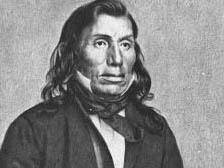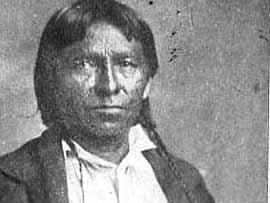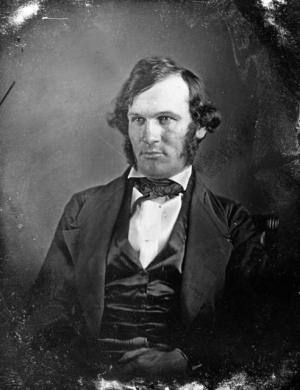"There is one thing more which our Great Father can do. He can gather us all together on the prairie and surround us with soldiers and shoot us down."
Wabasha, reflecting on the Treaty of Mendota
The Treaty of Mendota was signed at Pilot Knob in Mendota, Minnesota on August 5, 1851 following the Treaty of Traverse des Sioux on July 23rd. Between the United States federal government and the Mdewakanton and Wahpekute bands, it outlined much the same agreement as the previous treaty. The bands were to receive the interest on $1,410,000 that was to be applied to agricultural implements, provisions, education, and annuities in return for relocating to the Lower Sioux Agency near present-day Morton and ceding much of their remaining territory in southwestern Minnesota. Exasperated, Little Crow and other leaders who initially refused to sign, did so based on promises that funds would be paid from previously unpaid treaty agreements. The treaty was ratified by congress and these promises did not come to pass.
Article 1 and 2 stated the following:
"The peace and friendship existing between the United States and the Med-ay-wa-kan-toan and Wah-pay-koo-tay bands of Dakota or Sioux Indians shall be perpetual.
The said Med-ay-wa-kan-toan and Wah-pay-koo-tay bands of Indians do hereby cede and relinquish all their lands and all their right, title and claim to any lands whatever, in the Territory of Minnesota, or in the State of Iowa."
Signers of the treaty were (names as in document):
L. Lea.
Alex. Ramsey.
Med-ay-wa-kan-toans.
Chief Ta-oya-te-duta, (his scarlet people, or “Little Crow,”)
Headmen Wa-kan-o-zhan, (Sacred Light, or Medicine Bottle,)
Tee-tchay, (Top of the Lodge or “Jim.” or “Old Thad,”)
Ta-tchan-h' pee-sa-pa, (His “Black Tomahawk.”)
Ma-ka-na-ho-toan-ma-nee, (At whose tread the earth resounds,)
H'-da-ee-yan-kay, (he runs rattling,)
Too-kan-a-hena-ma-nee, (Walker on the Medicine Boulders or Stones,)
Wa-m'dee-doo-ta, (Scarlet War Eagle,)
Na-ghee-yoo-shkan, (He moves the Ghosts or Shadows,)
Shoank'-a-ska, (“White Dog,”)
Hoo-sa-nee-ghee, (one leg yellow or orange colored,)
Wa-keen-yan-wash-tay, (“Good Thunder,”)
Chief Wa-pa-sha, (The Standard, or “Red Leaf,”)
Headmen Wa-kan-hendee-o-ta, (Many Lightnings,)
Tchan-h'pee-yoo-ka, (He has a war club,)
Heen-han-doo-ta, (Red Owl,)
Ma ka-ka-ee-day, (He sets the Earth on fire,)
Ee-a-hee-herday, (He bursts out speaking,)
Chief Wa-koo-tay, (The “Shooter,”)
Headmen Ma-h'pee-ya-ma za, (Metal cloud,)
Ta-ma-za-ho-wash-tay, (his good iron voice,)
Ma-ka ta-na-zheen, (He stands on the earth,)
Ee-wan-kam-ee-na-zhan, (He stands above,)
Wa-kan-ta-pay-ta, (The Spirit's Fire,)
Na-ghee-mee-tcha-keetay, (He kills the Ghosts,)
Een-yan-sha-sha, (Red Stones,)
Ee-day-wa-kan, (Sacred Blaze,)
Ta-sag-yay-ma-za, (His metal Staff,)
Chief Ma-h'pee mee-tchash-tay, (man of the sky,)
Headmen Wee-tchan-h'pee, (The Star,)
Ta-tay-na-zhee-na, (Little standing Wind,)
Headmen Hoak-shee-dan-doo-ta, (Scarlet Boy,)
Am-pay-sho-ta, (Smoky Day,)
Ha-ha-ka-ma-za, (Metal Elk,)
Ta - tay - h'moo - he - ya - ya, (“Whistling Wind,”)
Wa-pa-ma-nee, (He strikes walking,)
Ma-h'pee-ya-wa-kan, (Sacred Cloud,)
Ta-tchan-h'pee-ma-za, (His Iron War Club,)
Chief Ma-za-ho-ta, (Gray Metal,)
Headmen Wa-soo-mee-tchash-ta-shnee, (Wicked or “Bad Hail,”)
Oan-ketay-hee-dan, (Little Water-God or “Little Whale,”)
Tcha-noon-pay-sa, (The Smoker,)
Ta-tay-to-kay-tcha, (Other wind,)
Ka-ho, (The Rambler about,)
Chief Ta-tchan-koo-wash-tay, (Good Road,)
Headmen Ta-tay-o-wo-teen-ma-nee, (Roaring Wind that walks,)
O-yay-tchan-ma-nee, (Track Maker,)
Ta-shoark-ay, (His Dog,)
Chief Sha-k'pay, (“Six,”)
Headmen A-no-ghee-ma-zheen, (He that stands on both sides,)
Hoo-ya-pa, (Eagle Head,)
Ta-tay-mee-na, (Round Wind,)
Ka-t'pan-t' pan-oo, (He comes pounding to pieces,)
Ma-h'pee-ya-henda-keen-yan, (Walking across a cloud,)
Wa-pee-ghee, (The orange red speckled cloud,)
Ma-za-wa-menoo-ha, (Gourd shell metal medicine rattle,)
Chief Hay-ee-tcha-h'moo-ma-nee, (Horn whistling walking,)
Headmen Pay-pay, (Sharp,)
Ta-wo-ta-way-doo-ta, (His Scarlet Armor,)
Hay-pee, (Third Son,)
A-pay-ho-ta, (Grey mane or crest,)
Ho-tan-een, (His voice can be heard,)
Ma-h'pee-ya-shee-tcha, (Bad Cloud,)
Ta-wa-tcheen, (His mind,)
Han-yay-too-ko-kee-pa-pee, (Night which is feared,)
In presence of Thomas Foster, Secretary. Nathaniel McLean, Indian Agent. Alexander Fariboult, P. Prescott, G. H. Pond, Interpreters. David Olmstead; W. C. Henderson; Alexis Bailly; Richard Chute; A. Jackson; A. L. Larpenteur; W. H. Randall, Sr.; A. S. H. White; H. L. Dousman; Frederic B. Sibley; Marten McLeod; Geo. H. Faribault.



